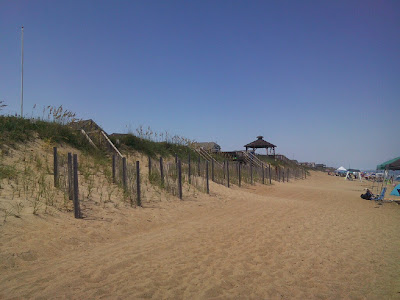OBX
The Outer Banks and Cape Hatteras, especially, are very meaningful to Taylor. It's his 'happy place', if you will. Since we met I have heard him talk about the famous lighthouse Cape Hatteras.
The image of a lighthouse alone holds a lot of symbolism. Taylor took a surf trip to the Outer Banks in his teen years, and it had a profound effect on him. It may not have been the place, but the time in his life that he was open to such an experience. Although, he would argue it was the place. Whichever the case may be, Hatteras and the Outer Banks is truly a special place.
Climbing the epic tower to the top, you cannot help but feel the significance of the historical mariner's navigator.
The importance of such an edifice is undeniably crucial. The beacon of light offers a reference point for ships sailing in darkness, whether it be dusk, night, or fog.

In our first apartment we had a miniature replica of Cape Hatteras on a ledge between our kitchen and living room, on it Taylor put a sticker along the curving white stripe, which read, 'Brother's Keeper'. This mini lighthouse I looked at many times a day and thought of often. It became a beacon for me.
I thought of all the ships this lighthouse guided and saved from crashing into shallow ground.
In the 1700s, Ocracoke Inlet was one of the busiest inlets in the East. It was one of the few navigable waterways for ships accessing inland ports such as Elizabeth City, Edenton or New Bern. It was here that Blackbeard the pirate found the inlet's heavy shipping traffic ripe for easy pickings.

The Cape Hatteras Lighthouse protects one of the most hazardous sections of the Atlantic Coast. Offshore of Cape Hatteras, the Gulf Stream collides with the Virginia Drift, a branch of the Labrador Current from Canada. This current forces southbound ships into a dangerous twelve-mile long sandbar called Diamond Shoals. Hundreds and possibly thousands of shipwrecks in this area have given it the reputation as the “Graveyard of the Atlantic”.
 Drew
Drew


 The beaches along Cape Hatteras National Seashore sparkle at night. When you kick the sand, you disturb tiny dinoflagellates like seasparkle. A chemical reaction causes them to glow with a blue-green light.
The beaches along Cape Hatteras National Seashore sparkle at night. When you kick the sand, you disturb tiny dinoflagellates like seasparkle. A chemical reaction causes them to glow with a blue-green light.







 Our neighborhood (view from the third story).
Our neighborhood (view from the third story).














